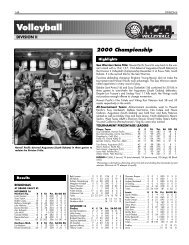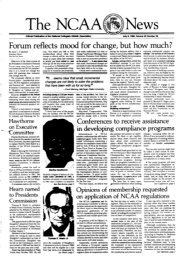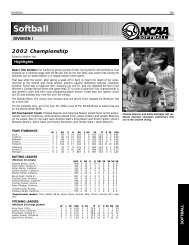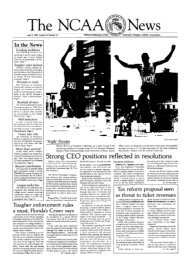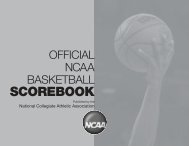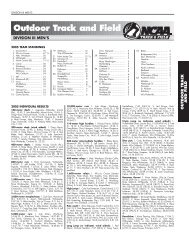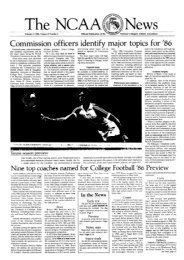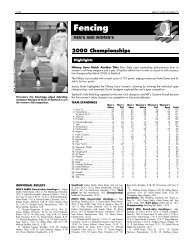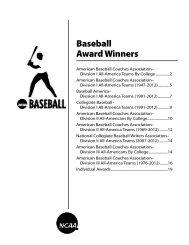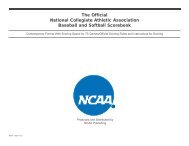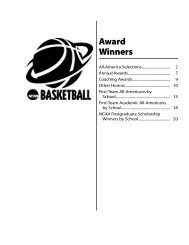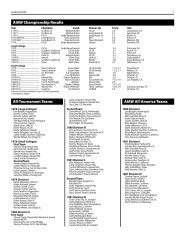Sports Medicine Handbook - NCAA
Sports Medicine Handbook - NCAA
Sports Medicine Handbook - NCAA
Create successful ePaper yourself
Turn your PDF publications into a flip-book with our unique Google optimized e-Paper software.
50<br />
“Burners”<br />
(Brachial Plexus<br />
Injuries)<br />
June 1994 • Revised June 2003<br />
The majority of stingers<br />
occur in football. Such<br />
injuries have been<br />
reported in 52 percent<br />
of college football<br />
players during a single<br />
season. As many as 70<br />
percent of college<br />
football players have<br />
experienced stingers.<br />
Stingers also can occur<br />
in a variety of other<br />
sports, including<br />
basketball, ice hockey,<br />
wrestling and some field<br />
events in track.<br />
GUIDELINE 2h<br />
“Burners” or “stingers” are so<br />
named because the injuries can<br />
cause a sudden pain and numbness<br />
along the forearm and hand. The<br />
more formal medical terminology<br />
is transient brachial plexopathy or<br />
an injury to the brachial plexus. A<br />
brachial plexus injury may also<br />
involve injury to a cervical root.<br />
An injury to the spinal cord itself<br />
is more serious and frequently does<br />
not fall under this category of injury,<br />
although it shares certain symptoms;<br />
therefore, spinal cord injuries<br />
should be ruled out when diagnosing<br />
stingers.<br />
The majority of stingers occur in<br />
football. Such injuries have been<br />
reported in 52 percent of college<br />
football players during a single<br />
season. As many as 70 percent of<br />
college football players have<br />
experienced stingers. Stingers<br />
also can occur in a variety of<br />
other sports, including basketball,<br />
ice hockey, wrestling and some<br />
field events in track.<br />
Mechanism<br />
The most common mechanism for<br />
stingers is head movement in an<br />
opposite direction from the shoulder<br />
either from a hit to the head or<br />
downward traction of the shoulder.<br />
This can stretch the nerve roots on<br />
the side receiving the blow (traction),<br />
or compress or pinch those<br />
on the opposite side. Contact to<br />
the side of the neck may cause a<br />
direct contusion to the brachial<br />
plexus. In football, improper<br />
blocking and tackling techniques<br />
may result in a brachial plexus<br />
injury. Coaches, parents and student-athletes<br />
should be cautioned<br />
regarding the consequences of<br />
improper techniques, which may<br />
result in cervical spine injuries or<br />
trauma to the brachial plexus.<br />
Symptoms and Severity<br />
Student-athletes who suffer burners<br />
may be unable to move the<br />
affected arm from their side and<br />
will complain of burning pain,<br />
and potentially, numbness traveling<br />
from the injured side of the<br />
neck through the shoulder down<br />
the arm and forehand, and sometimes<br />
into the hand. Weakness<br />
may be present in the muscles of<br />
the shoulder, elbow and hand.<br />
Brachial plexus injuries can be<br />
classified into three categories.<br />
The mildest form (Grade 1) are<br />
neuropraxic injuries that involve<br />
demyelination of the axon sheath<br />
without intrinsic axonal disruption.<br />
Compete recovery typically occurs<br />
in a few seconds to days. Grade 1<br />
injuries are the most common in<br />
athletics. Grade 2 injuries involve<br />
axonotmesis or disruption of the<br />
axon and myelin sheath with pres-



